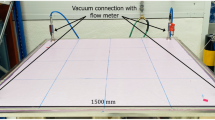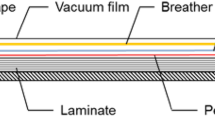Abstract
The presence of leakages in composite manufacturing vacuum bag layups results in undesirable defects and low-quality products. Thus, it is crucial to locate leakages before injecting the resin. A reliable method is to estimate the location of the leakages by monitoring the flowrates of vacuum ports. However, these estimations based on traditional numerical methods often fail because of model inadequacies, extensive size of the vacuum bags, complex geometries and port configurations. Machine learning can be used for estimation, but it requires large datasets to capture the flow characteristics of every possible leakage location of various layup configurations. Generating such datasets in real manufacturing settings is prohibitively time-consuming and labor-intensive. We propose a novel analogy between vacuum bag assemblies and electrical circuits for flowrate data generation. This model has been experimentally validated for various geometries and patterns and acts as an accurate analogue for the real setup with an accuracy of more than 97%. Two machine learning–based models have also been trained with a validation accuracy of 94% that have a suitable prediction in regions far from the boundaries.













Similar content being viewed by others
Data availability
Data can be provided upon request.
References
Goren A, Atas C (2008) Manufacturing of polymer matrix composites using vacuum assisted resin infusion molding. Arch Mater Sci Eng 34:117–120
Potter KD (1999) The early history of the resin transfer moulding process for aerospace applications. Compos A Appl Sci Manuf 30:619–621
Centea T, Grunenfelder LK, Nutt SR (2015) A review of out-of-autoclave prepregs–material properties, process phenomena, and manufacturing considerations. Compos A Appl Sci Manuf 70:132–154
Advani SG, Hsiao KT (eds) (2012) Manufacturing techniques for polymer matrix composites (PMCs). Elsevier
Campbell FC Jr (2003) Manufacturing processes for advanced composites. Elsevier
Hindersmann A (2019) Confusion about infusion: an overview of infusion processes. Compos A Appl Sci Manuf 126:105583
Köber M, Eberth U (2007) Laminieren für Profis—Ein Trainingshandbuch für Faserverbundwerkstoffe, 2nd edn. Auflage, Airbus Deutschland GmbH, Hamburg
Brockmann R (2016) Ultra Sniffer–new leak detection method, 19th World conference on non-destructive testing 2016
Haschenburger A, Menke N (2018) Sensor based analysis and identification of leakages in vacuum bagging for high performance composite components. In: International SAMPE technical conference series
Lane MD, Poursartip A, Fernlund G, Floyd AM, Van Ee DA, Hibbert MEJ (2013) Detection, monitoring, and management of gas presence, gas flow and gas leaks in composites manufacturing, Canada Patent No. CA2817791A1
Jens Bölke HU, Stefaniak D, Krombholz C (2014) Leakage detection, Germany Patent DE102011100096B4
Advani SG, Zhou F, Alms JB, Corlay CC (2010) System and method of detecting air leakage in a VARTM process, US Patent No. US7762122B2
Liu X, Li J, Zhu J, Wang Y, Qing X (2021) Cure monitoring and damage identification of CFRP using embedded piezoelectric sensors network. Ultrasonics 115:106470
Miller FB, Benne ME (2013) Leak detection in vacuum bags. US Patent No. US8505361B2
Haschenburger A, Heim C (2019) Two-stage leak detection in vacuum bags for the production of fibre-reinforced composite components. CEAS Aeronaut J 10:885–892
Brill E, Lin JJ, Banko M, Dumais ST, Ng AY (2001) Data-intensive question answering. In: TREC, p 90, In Proceedings of the Tenth Text Retrieval Conference (TREC 2001), November 2001, Gaithersburg, Maryland
Sun X, Li S, Lee LJ (1998) Mold filling analysis in vacuum-assisted resin transfer molding. Part I: SCRIMP based on a high-permeable medium. Polym Compos 19:807–817
Kang M, Lee W, Hahn H (2001) Analysis of vacuum bag resin transfer molding process. Compos A Appl Sci Manuf 32:1553–1560
Han K, Jiang S, Zhang C, Wang B (2000) Flow modeling and simulation of SCRIMP for composites manufacturing. Compos A Appl Sci Manuf 31:79–86
Correia N, Robitaille F, Long A, Rudd C, Šimáček P, Advani SG (2004) Use of resin transfer molding simulation to predict flow, saturation, and compaction in the VARTM process. J Fluids Eng 126:210–215
Nugroho G, Pranoto I, Rohmana NZ (2018) Effect of breather type and vacuum pressure on the manufacturing of an unmanned aerial vehicle fuselage using vacuum bagging method. In: AIP Conference Proceedings, p 040005
Haschenburger A, Menke N, Stüve J (2021) Sensor based leakage detection in vacuum bagging, Int J Adv Manuf Technol 116:2413–2424
Chen R, Dong C, Liang Z, Zhang C, Wang B (2004) Flow modeling and simulation for vacuum assisted resin transfer molding process with the equivalent permeability method. Polym Compos 25:146–164
Convergent. COHO 102 single channel handheld leak detection. Catalogue. In: COHO, Convergent, Ed., ed, p 2, available at: www.convergent.ca
Funding
The authors would like to acknowledge the support of the Natural Sciences and Engineering Council Canada (NSERC) and Convergent Manufacturing Technologies Inc. program Grant PIDT GR017570 NSERC 2020 towards this research.
Author information
Authors and Affiliations
Corresponding author
Ethics declarations
Conflict of interest
The authors declare no competing interests.
Additional information
Publisher's note
Springer Nature remains neutral with regard to jurisdictional claims in published maps and institutional affiliations.
Rights and permissions
Springer Nature or its licensor (e.g. a society or other partner) holds exclusive rights to this article under a publishing agreement with the author(s) or other rightsholder(s); author self-archiving of the accepted manuscript version of this article is solely governed by the terms of such publishing agreement and applicable law.
About this article
Cite this article
Esmaeili, Y.R., Cosco, B. & Najjaran, H. Vacuum bag leak detection for resin infusion: an electric current–based analogy. Int J Adv Manuf Technol 124, 1775–1786 (2023). https://doi.org/10.1007/s00170-022-10552-1
Received:
Accepted:
Published:
Issue Date:
DOI: https://doi.org/10.1007/s00170-022-10552-1




